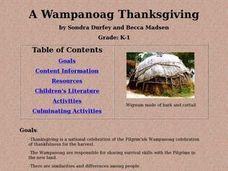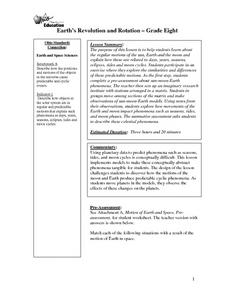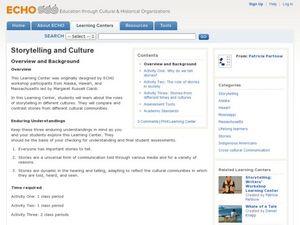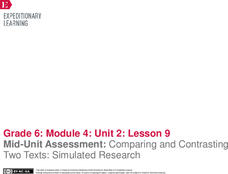Curated OER
A Wampanoag Thanksgiving
Students examine how the Wampanoag tribe celebrated Thanksgiving. They discover how they helped the Pilgrims when they first came to the New World. They identify the similarities and differences between people.
Curated OER
Earth's Revolution and Rotation
Eighth graders investigate the regular motions of the sun, Earth and the moon and explain how these are related to days, years, seasons, eclipses, tides and moon cycles. They participate in an exercise where they explore the...
Curated OER
Sound--Music or Noise?
Students are introduced to the concept of sound and how it is presented in the world around them. Using scientific terms, they describe the properties of sound and create their own definitions of sound, music, and noise. They demonstrate...
Curated OER
Phiolosophy and Politics
Students study about Aristotle, Plato, and Socrates and how their role affected the Greek culture. They look at a video clip from Bill and Ted's Excellent Adventure and note similarities and differences from the movie and what is in...
Curated OER
Evolution of Life
Students explore the evolution of life. They read sections of their text and make a foldable of the key vocabulary terms. They identify two types of butterflies and represent their similarities and differences on a Venn diagram. They...
Curated OER
Urban and Rural Communities
Students discuss similarities and differences of urban and rural communities. In this urban and rural communities lesson, students compare urban and rural communities using a Venn Diagram. Students examine maps of each type...
Curated OER
Earth
Fourth graders have a spatial awareness of the plants by orally discussing what they saw after they stepped out the model of the solar system. They recognize the similarities and differences between Earth and the other planets by being...
Curated OER
Life Reflections in Songwriting and Poetry
Students analyze, discuss and compare sources of inspiration, use of words and imagery, and other differences in writing styles between two featured songwriters. This is an introductory lesson plan to a creative project unit.
Earth Day Network
Conserving Water Through Art!
Having fresh, clean drinking water is a privilege many people take for granted. Help raise awareness about the scarcity of water and the importance of conservation by discussing different ways water is used in everyday life. Brainstorm...
Equality and Human Rights Commission
Learning area 2: Challenging Stereotypes and Discrimination
Six powerful and eyeopening lessons provide scholars with activities designed to challenge stereotypes and discrimination. The unit provides reading material with which pupils read and discuss. Grand conversations lead to physically...
Teach-nology
Reading Comprehension: Compare and Contrast
What do a zoo and a farm have in common? Second graders read about each place, and compare and contrast the details using two multiple choice questions.
Curated OER
Storytelling and Culture
Students examine the cultural tradition of storytelling. In this storytelling lesson, students explore stories from 3 different cultures and evaluate the roles that storytelling plays in each of the cultures to pass on values and beliefs.
Rainforest Alliance
Colombia Biodiversity
How diverse is the rainforest? How much more diverse is a rain forest than a temperate forest? Explore these focus questions in a lesson that explores the plants, animals, and insects in forests. After listening to a reading...
Curated OER
Families Eat Rice - Lesson Plan
Students participate in a shared writing experience about rice. In this writing lesson, students listen to Norah Dooley's, Everybody Cooks Rice. They write about, and discuss different ways their families and those in the book use...
Curated OER
Cell Biology
Identify the different cell organelles in prokaryotes. Modelling the cells using Jell-o and candies will be a fun way to experience the cell in a hands-on way (different to using play-doh!). They observe cells under a microscope and draw...
WK Kellogg Biological Station
Sounds of Selection
Do you want a creative and fun way to teach about natural selection? Hop to it by turning your middle school princes and princesses into frogs trying to catch as many bugs as possible in a Hungry Hungry Hippos style game. For high...
EngageNY
Comparing Linear and Exponential Models Again
Making connections between a function, table, graph, and context is an essential skill in mathematics. Focused on comparing linear and exponential relationships in all these aspects, this resource equips pupils to recognize and interpret...
Virginia Department of Education
Historical Models of Atoms
What does the past have to do with today? Young scientists find that answer as they learn more about past chemists and their significant contributions to the field. Pupils use the Internet to research historical figures...
West Contra Costa Unified School District
Polynomial Division
Multiply the ways your scholars can find the quotient with polynomial division. A lesson introduces polynomial division via long division, synthetic division, generic area model, and using the definition of division. Learners then...
Science Matters
A Model of Plate Faults
The San Andreas fault is one of the longest fault zones in the world. In a series of 20 lessons, the fourth lesson has pupils use a paper model to recreate various types of plate faults. Each is held in position then drawn...
Curated OER
Children of War
Take a closer look at the impact of war in this language arts and social studies activity. Middle schoolers use primary sources to conduct research as they relate to the effects of war on children. They compare and contrast the effects...
EngageNY
Mid-Unit Assessment: Comparing and Contrasting Two Texts: Simulated Research
Shoo fly. Scholars read DDT Spray Scares Mosquitoes Away, Study Finds and You Think You Have It Tough? to complete a mid-unit assessment. The learners compare and contrast author presentation and conduct a credibility check on each...
Prince William Network
The Incredible Journey
Divide your school gym into breeding grounds and non-breeding grounds so that your zoologists can play a game simulating the seasonal migration of shorebirds. Players pick one of the included game cards and follow its directions, which...
Curated OER
Act it Out: Dramatizing Asian American Stories
Read and act out folktales, fairy tales, or myths from various Asian American cultures with your class. Each group reads a story aloud and then works together to create a short play or skit about the story. Suggestions for stories are...























